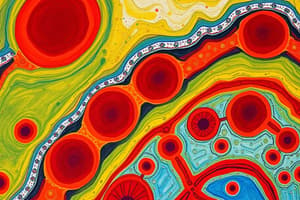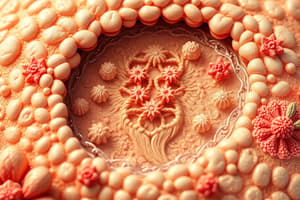Podcast
Questions and Answers
In the epidermis, waterproofing materials are produced by which type of cells?
In the epidermis, waterproofing materials are produced by which type of cells?
- Melanocytes
- Keratinocytes (correct)
- Langerhans cells
- Merkel cells
In the epidermis, keratinocytes fill with keratin, flatten, and undergo apoptosis in which layer?
In the epidermis, keratinocytes fill with keratin, flatten, and undergo apoptosis in which layer?
- Stratum basale
- Stratum granulosum (correct)
- Stratum spinosum
- Stratum corneum
What is the primary function of melanocytes in the epidermis?
What is the primary function of melanocytes in the epidermis?
- Act as a defense mechanism
- Provide sensory function
- Produce keratin
- Produce melanin (correct)
Which of the following accurately describes the reticular layer of the dermis?
Which of the following accurately describes the reticular layer of the dermis?
What structural feature interlocks the papillary layer of the dermis with the epidermis?
What structural feature interlocks the papillary layer of the dermis with the epidermis?
Which layer of skin serves as insulation and energy storage?
Which layer of skin serves as insulation and energy storage?
Which type of tissue is specialized for contraction and generates tension?
Which type of tissue is specialized for contraction and generates tension?
Langerhans cells in the epidermis primarily serve what purpose?
Langerhans cells in the epidermis primarily serve what purpose?
What is the main function of arrector pili muscles?
What is the main function of arrector pili muscles?
What provides flexible support in the human body?
What provides flexible support in the human body?
Which statement about the stratum lucidum is true?
Which statement about the stratum lucidum is true?
Which of these is NOT a function of the integumentary system?
Which of these is NOT a function of the integumentary system?
Which type of melanin is primarily responsible for brown and black colors in hair and skin?
Which type of melanin is primarily responsible for brown and black colors in hair and skin?
Which component is considered part of the hypodermis?
Which component is considered part of the hypodermis?
Which glands are responsible for producing viscous secretions that may cause body odor?
Which glands are responsible for producing viscous secretions that may cause body odor?
Which layer of skin contains blood vessels and nerves?
Which layer of skin contains blood vessels and nerves?
What type of secretion do eccrine sweat glands produce?
What type of secretion do eccrine sweat glands produce?
Which statement is true about sebaceous glands?
Which statement is true about sebaceous glands?
What is a characteristic of epithelial tissue?
What is a characteristic of epithelial tissue?
Which of the following best describes endocrine glands?
Which of the following best describes endocrine glands?
Which of these cell shapes is NOT a type associated with epithelial tissue?
Which of these cell shapes is NOT a type associated with epithelial tissue?
Which statement about the mesothelium is true?
Which statement about the mesothelium is true?
What type of gland is represented if a structure has a rounded exterior and tubular interior?
What type of gland is represented if a structure has a rounded exterior and tubular interior?
The serous membranes lining the chest cavity are known as?
The serous membranes lining the chest cavity are known as?
Which of the following describes the function of mucous membranes?
Which of the following describes the function of mucous membranes?
What does the term 'parietal' refer to in the context of serosal membranes?
What does the term 'parietal' refer to in the context of serosal membranes?
What is the characteristic of dense regular connective tissue?
What is the characteristic of dense regular connective tissue?
Which of the following best describes the role of fibroblasts in connective tissue?
Which of the following best describes the role of fibroblasts in connective tissue?
Which type of connective tissue primarily provides energy storage?
Which type of connective tissue primarily provides energy storage?
What type of connective tissue has thick collagen fibers arranged in a woven pattern?
What type of connective tissue has thick collagen fibers arranged in a woven pattern?
Which type of cells mature into osteocytes?
Which type of cells mature into osteocytes?
Which statement about connective tissue is true?
Which statement about connective tissue is true?
Which cells are primarily involved in the defense response within connective tissue?
Which cells are primarily involved in the defense response within connective tissue?
What type of connective tissue is characterized by a three-dimensional network of fibers in a gelatinous matrix?
What type of connective tissue is characterized by a three-dimensional network of fibers in a gelatinous matrix?
Flashcards are hidden until you start studying
Study Notes
Epidermis Overview
- Composed primarily of keratinocytes, which produce keratin, move from deep to superficial layers, and eventually die off.
- Melanocytes produce melanin, providing protection against UV radiation and are transferred to keratinocytes.
- Contains Merkel cells for sensory functions and Langerhans cells for immune defense.
Layers of the Epidermis
- Stratum Basale: Single layer with keratinocyte stem cells; contains melanocytes and Merkel cells.
- Stratum Spinosum: Multiple layers of keratinocytes; Langerhans cells present; melanin is transferred to keratinocytes.
- Stratum Granulosum: Keratinocytes secrete waterproofing and antimicrobial substances; cells fill with keratin and flatten.
- Stratum Lucidum: Present in palms, fingertips, and soles; consists of clear, flat, dead keratinocytes.
- Stratum Corneum: Thickest layer made of dead keratin-filled cells; constantly shed.
Dermis Structure
- Composed of strong, flexible connective tissue with nerves, blood vessels, hair follicles, and glands.
- Papillary Layer: Areolar connective tissue with projections (papillae) that interlock with the epidermis, assisting with grip on hands and feet.
- Reticular Layer: Dense irregular connective tissue featuring tough collagen and elastic fibers.
Hypodermis (Subcutaneous Layer)
- Comprised of adipose and areolar connective tissue.
- Functions include anchoring skin to underlying structures, insulation, energy storage, and cushioning.
Connective Tissue Types
- Divided into loose connective tissues (areolar, reticular) and fibrous connective tissues (dense regular, dense irregular).
- Specialized connective tissues include cartilage, bone, and blood, which have fewer cells and more extracellular matrix.
Epithelial Tissue Characteristics
- Cell shapes: squamous (flattened), cuboidal (cube-like), columnar (tall and thin).
- Layering: simple (single layer) vs. stratified (multiple layers).
- Glands: Endocrine glands secrete hormones into blood; exocrine glands secrete through ducts.
Epithelial Membranes and Functions
- Epithelial membranes contain a basement membrane and include cutaneous (skin), mucous (lining of tracts), and serous membranes (line body cavities).
- Serous membranes are named based on location: pleura (lungs), pericardium (heart), and peritoneum (abdominal cavity).
Muscle and Nervous Tissue
- Muscle tissue functions in contraction and includes skeletal, cardiac, and smooth types.
- Nervous tissue specializes in conducting electrical impulses.
Integumentary System Functions
- Includes skin, hypodermis, hair, nails, and glands.
- Provides defense, prevents desiccation, waterproofing, UV protection, vitamin D synthesis, thermoregulation, and sensory reception.
Hair and Glands
- Hair consists of dead keratinocytes and provides sensory functions, insulation, and protection.
- Arrector pili muscles attached to hair follicles cause hair to stand erect.
- Sebaceous glands release sebum for lubrication; eccrine glands produce sweat for cooling and waste elimination; apocrine glands produce thicker secretions, often associated with odor.
Key Understanding
- Epithelial tissues and their structures play critical roles in protection and secretion.
- The dermis provides structural support and houses essential cells and structures.
- Understanding the integumentary system is crucial for recognizing its wide range of functions in health and regulation.
Studying That Suits You
Use AI to generate personalized quizzes and flashcards to suit your learning preferences.




